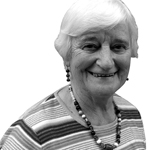On the pilgrim way: The ghosts of Berlin’s past - Reform Magazine
 We spent five hot days in Berlin this summer, and I am still trying to sift through the experience – the layers of history, the various perspectives and my own reactions.
We spent five hot days in Berlin this summer, and I am still trying to sift through the experience – the layers of history, the various perspectives and my own reactions.
My mother came from south Germany; she never visited Berlin, but regarded it as a modern day Babylon – a sink of iniquity. When the Wall came down, my Marxist German cousin felt like much that was socially enlightened and culturally interesting was lost as the capitalist West took over. Our guide for this visit was his daughter, Gisela, a graphic artist who has lived in old East Berlin for the past 15 years.
We stayed near her flat, in the midst of a noisy, vibrant, trendy area: high-class graffiti and buskers, streets of cafes and little craft shops, a terrifying number of bicycles sharing the pavements with pedestrians, old trams and newer S-Bahn. We climbed four flights to her tiny flat overlooking a quiet courtyard, and she pointed out the bullet holes scattered over the opposite wall. In 1945 (long before she was born) the Red Army had fought street by street, courtyard by courtyard, for Berlin. We then began to distinguish old from newer buildings by their bullet holes.
Perhaps because of our age, and our German and Dutch mothers, we could not avoid the war. We walked around what had been the Jewish quarter and visited the New Synagogue – “new” in 1859, though the façade has been carefully restored with precious remains on display inside. It is, of course, heavily policed. In a nearby square, surrounded by grass and rose beds, stood a sculpture entitled The Deserted Room: a table with one chair and another knocked over, as if the people had suddenly fled or been dragged away. Further down the street was the old Jewish cemetery; it had been desecrated during the war, and then, in the terrible last months of the war, used for mass graves for over 2,000 Berliners. It is now a peaceful place where Jew and Gentile lie together. And on a wall nearby, a community peace project was taking place – children and adults making a vast picture of doves and flowers out of tiny pieces of mosaic.
With some misgivings, we visited the central war memorial. It is a bombastic, 19th Century, little building erected to celebrate the German victories of that century. However, inside there is nothing but a large copy of a sculpture by Kathe Kollwitz, the passionately anti-war artist dismissed from her teaching post in 1935. It depicts an older mother cradling her dead son – no longer in anguish, but with deep love.
Young people of many nations had colonised a disused train repair yard near our hotel; impromptu cafes and stalls had sprung up; bands were playing; and a grim brick chimney over a war-time bunker was being used as a climbing wall.
They shall beat their swords into ploughshares … neither shall they learn war any more. (Micah 4:3)
Sheila Maxey is book reviews editor for Reform
___
This article was published in the September 2013 edition of Reform.
Read more articles by Sheila Maxey










Submit a Comment